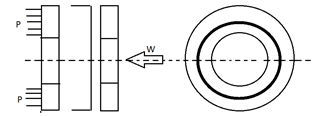1. Which of these is not a type of clutch?
a) Single disc
b) Conical
c) Centrifugal
d) Cylindrical
Explanation: Single disc, conical and centrifugal are types of clutches. Clutches are used for the transmission of power in shafts and machines which are started and stopped frequently. It is also used to deliver power to the machine which are partially or fully loaded.
2. Identify the clutch.
a) Single plate clutch
b) Conical clutch
c) Centrifugal clutch
d) Multi plate clutch
Explanation: The given diagram is of a single plate clutch. It consists of a clutch plate whose both sides are faced with Ferrodo (a friction material). It is mounted on the hub which moves along the splines of the shaft which is driven.
3. In a single plate clutch, considering uniform pressure, T = nµWR. What is R equal to?
a) 2(r13 + r23) / 3(r12 + r22)
b) 2(r13 – r23) / 3(r12 – r22)
c) (r1 – r2)/2
d) (r1 + r2)/2
Explanation: For uniform pressure theory, T = nµW(2(r13 – r23) / 3(r12 – r22))
Therefore, considering uniform pressure theory in a single plate clutch, T = nµWR where R = 2(r13 – r23) / 3(r12 – r22).
4. In a single plate clutch, considering uniform wear, T = nµWR. What is R equal to?
a) 2(r13 + r23) / 3(r12 + r22)
b) 2(r13 – r23) / 3(r12 – r22)
c) (r1 – r2)/2
d) (r1 + r2)/2
Explanation: For uniform wear, T = nµW((r1 + r2)/2)
Therefore, considering uniform pressure theory in a single plate clutch, T = nµWR where R = (r1 + r2)/2.
5. The intensity of pressure is minimum at the outer radius that is r1.
a) True
b) False
Explanation: The intensity of pressure is minimum at the outer radius that is r1. It is given by C/r1. The intensity of pressure is maximum at the inner radius which is r2.
6. In a single plate clutch, the pressure is uniformly distributed. If the outer and inner radii are 100 mm and 70 mm respectively, find the value of R.
a) 76.39 mm
b) 23.48 mm
c) 85.88 mm
d) 34.98 mm
Explanation: Considering uniform pressure theory in a single plate clutch, T = nµWR where R = 2(r13 + r23) / 3(r12 + r22)
Thus, here, R = 2(1003 – 703) / 3(1002 – 702) = 85.88 mm.
7. Maximum intensity of pressure is given by ____
a) C/R
b) C/R2
c) C/r2
d) C/r1
Explanation: We know that, pmax x r2 = C.
Thus, pmax = C/r2
Similarly, pmin = C/r1
8. When the pressure is uniformly distributed over entire area, then the intensity of pressure is _______________
a) W/ (π(r12 – r22)
b) W/ (π(r12 + r22)
c) W/ (π(r22 – r12))
d) W/ (π(r22 x r12))
Explanation: Pressure = Force / Area
Therefore, the intensity of pressure considering uniform pressure is W/ (π(r12 – r22).
9. For uniform wear, the axial thrust W = ______________
a) 2 π C (r2 + r1)
b) 2 π C (r1 – r2)
c) 2 π C (r2 – r1)
d) 2 π C (r1 x r2)
Explanation: In uniform wear theory, C = W/(2 π (r1 – r2))
Thus, W = 2 π C (r1 – r2).
10. Find the axial thrust to be provided by the springs if the maximum intensity of pressure in a single plate clutch should not exceed 0.2 N/mm2. The outer and the inner radius is 75 mm and 35 mm. Assume theory of uniform wear.
a) 1792.01 N
b) 1789.21 N
c) 1723.41 N
d) 1759.29 N
Explanation: Given: pmax = 0.2 N/mm2, r1 = 75 mm and r2 = 35 mm
Thus, W = 2 π C (r1 – r2) = 2 π C (r1 – r2) = 2 π x pmax x r2 (r1 – r2) = 2 π x 0.2 x 35 (75 – 35) = 1759.29 N.